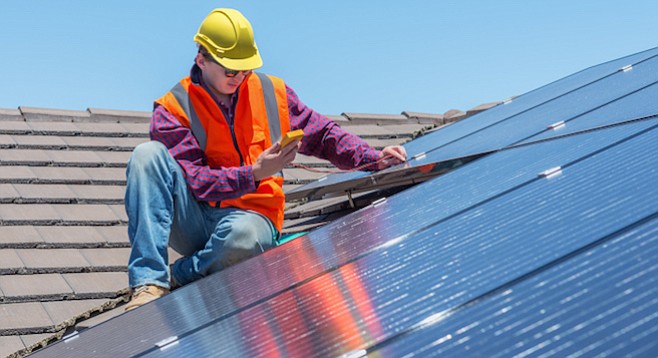 Facebook
Facebook
 X
X
 Instagram
Instagram
 TikTok
TikTok
 Youtube
Youtube

California's solar industry has been setting records, and then breaking them, for total energy generated from utility-scale solar installations all summer.
According to PV Magazine the California Independent System Operator, which controls the state's power grid, reported a new record for power generation at 6.16 gigawatts on June 7. For comparison's sake, that's roughly three times the output of the now-shuttered San Onofre Nuclear Generating Station when it was operating at full capacity.
By July 13, that record was shattered with a power generation just shy of 6.3 gigawatts, rising by about two-thirds of the output of the controversial new Pio Pico gas plant slated for construction in the Otay Mesa area.
Each successive peak generation record has fallen within a few days for the past month, and on August 20 generation topped 6.39 gigawatts.
Even these numbers are considered low, as they don't include any "behind-the-meter" solar generation, meaning small-scale rooftop installations done by consumers are not counted in the tally, only larger utility-scale projects such as those sited in the Imperial Valley east of San Diego.
Another 3.2 gigawatts of peak generation capacity is reportedly found in consumer-scale solar projects across the state, potentially adding another 50 percent of generation capacity to the cited present figures.
Opponents of renewable-heavy energy portfolios (Governor Jerry Brown has set a target of 50% renewable energy statewide by 2030) have long argued that solar is a risky basket in which to place one's eggs. What happens when the sun goes down and energy demand goes up?
The rationale has been used to argue in favor of new gas-fired power plants such as Pio Pico or the Carlsbad Energy Center proposed to replace a similar aging facility along the North County coast.
But, PV finds, components of a greener system including wind energy, which tends to pick up in the evening as the sun goes down as solar output fades, and energy storage systems (Arizona has a system that stores solar power up to six hours, Spain can bank green power for up to a day) can alleviate some of the concerns generated by inconsistencies in the weather. An increase in wind and solar generation statewide has already shifted the peak demand for traditional power plants from 5 p.m. to 9 p.m.


California's solar industry has been setting records, and then breaking them, for total energy generated from utility-scale solar installations all summer.
According to PV Magazine the California Independent System Operator, which controls the state's power grid, reported a new record for power generation at 6.16 gigawatts on June 7. For comparison's sake, that's roughly three times the output of the now-shuttered San Onofre Nuclear Generating Station when it was operating at full capacity.
By July 13, that record was shattered with a power generation just shy of 6.3 gigawatts, rising by about two-thirds of the output of the controversial new Pio Pico gas plant slated for construction in the Otay Mesa area.
Each successive peak generation record has fallen within a few days for the past month, and on August 20 generation topped 6.39 gigawatts.
Even these numbers are considered low, as they don't include any "behind-the-meter" solar generation, meaning small-scale rooftop installations done by consumers are not counted in the tally, only larger utility-scale projects such as those sited in the Imperial Valley east of San Diego.
Another 3.2 gigawatts of peak generation capacity is reportedly found in consumer-scale solar projects across the state, potentially adding another 50 percent of generation capacity to the cited present figures.
Opponents of renewable-heavy energy portfolios (Governor Jerry Brown has set a target of 50% renewable energy statewide by 2030) have long argued that solar is a risky basket in which to place one's eggs. What happens when the sun goes down and energy demand goes up?
The rationale has been used to argue in favor of new gas-fired power plants such as Pio Pico or the Carlsbad Energy Center proposed to replace a similar aging facility along the North County coast.
But, PV finds, components of a greener system including wind energy, which tends to pick up in the evening as the sun goes down as solar output fades, and energy storage systems (Arizona has a system that stores solar power up to six hours, Spain can bank green power for up to a day) can alleviate some of the concerns generated by inconsistencies in the weather. An increase in wind and solar generation statewide has already shifted the peak demand for traditional power plants from 5 p.m. to 9 p.m.
Comments